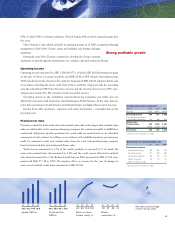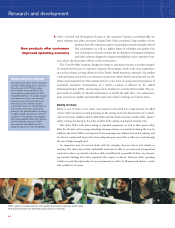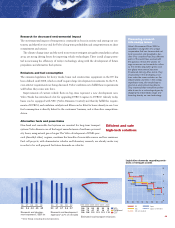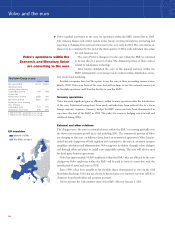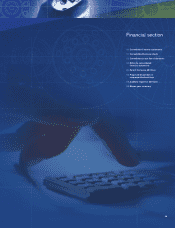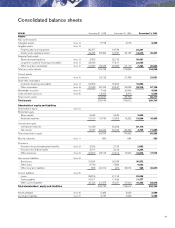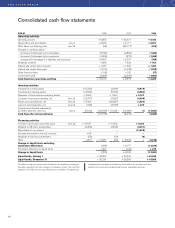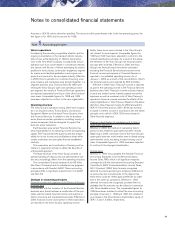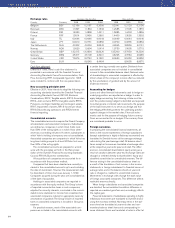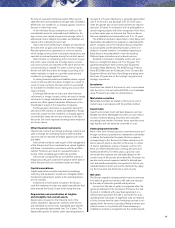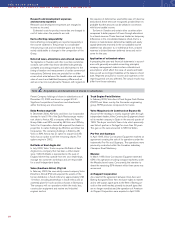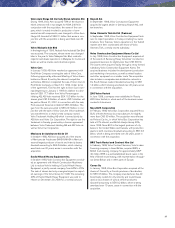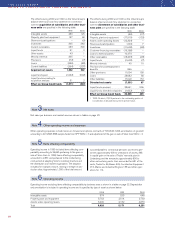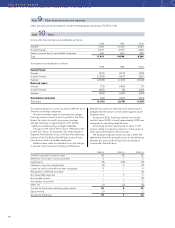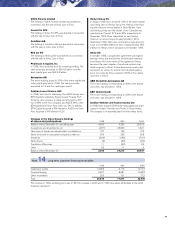Volvo 2000 Annual Report Download - page 55
Download and view the complete annual report
Please find page 55 of the 2000 Volvo annual report below. You can navigate through the pages in the report by either clicking on the pages listed below, or by using the keyword search tool below to find specific information within the annual report.
Notes to consolidated financial statements
53
Amounts in SEK M unless otherwise specified. The amounts within parentheses refer to the two preceding years; the
first figure is for 1999 and the second for 1998.
Earlier, these items were included in the Volvo Group’s
net interest income/expense. Comparable figures for
1998 and 1999 have been adjusted to conform to the
revised classification principle. As a result of the above,
the definition of the Volvo Group’s net financial assets
has also been modified. Effective in 2000, the Volvo
Group’s net financial assets have been calculated
excluding the Financial Services business area since
financial income and expense in Financial Services is
reported in consolidated operating income. As of
January 1, 2000, as a result of the new definition, Volvo’s
net financial assets were reduced by SEK 2.2 billion.
Effective in 2000, Volvo Treasury’s income is reported
as part of the operating income in the Financial Services
business area. Volvo Treasury’s income includes interest
income and similar income, interest expense and similar
expenses, as well as overhead costs of Volvo Treasury’s
operations. However, income excludes the effects of the
equity-capital base in Volvo Treasury. Based on the above
definition, Volvo Treasury’s income for 2000 amounted to
SEK 151 M. Of this amount, SEK 183 M was formerly
included in interest income in accordance with the earlier
principle, and a deficit of SEK 32 M was included in
Other financial expenses.
Change in identification of overhead costs in Volvo’s
spare-parts operations
Effective in 2000, the method of calculating Volvo’s
product costs related to spare parts has been revised.
Beginning in 2000, overhead costs of the Volvo Group’s
spare-parts business, which earlier were included among
administrative costs, are being included among cost of
sales. Comparable figures for 1999 have been adjusted
to conform to the changed classification.
Income taxes
Effective in 1999, Volvo adopted the Swedish Financial
Accounting Standards Councils Recommendation,
Income Taxes, RR9, which in all significant respects
corresponds with the International Accounting Standard
Committee’s (IASC’s) recommendation, Income Taxes,
IAS 12 (revised 1996). Volvo formerly recognized
deferred tax assets pertaining to temporary differences,
as well as tax loss carryforwards, to the degree that
these items could be netted against deferred tax liabil-
ities in the same tax jurisdiction. Effective in 1999,
deferred tax assets are recognized, provided that it is
probable that the amounts can be utilized in connection
with future taxable income. The comparable figures for
1998 have been restated to reflect the new accounting
principle. At January 1, 1998 and 1999, this resulted in
an increase in the Volvo Group’s shareholders’ equity of
SEK 1.5 and 1.3 billion, respectively.
Volvo’s operations
Considering the prevailing competitive situation and the
ongoing consolidation in the transport vehicle industry,
Volvo chose at the beginning of 1999 to divest Volvo
Cars to the Ford Motor Company. Consequently, Volvo’s
operations are now concentrated in commercial vehicles
and service with the aim of further developing its market
positions in trucks, buses, construction equipment, engines
for marine and industrial applications and engine com-
ponents and service for the aerospace industry. Effective
in 2000, Volvo’s operations in customer-financing, insur-
ance, treasury and real estate were brought together in a
separate business area, Financial Services. When pre-
senting the Volvo Group’s sales and operating income
per segment, the results of Financial Services operations
are reported separately from those of the other five busi-
ness areas. Comparable figures for 1998 and 1999
have been adjusted to conform to the new organization.
Operating structure
The Volvo Group’s operations during 2000 were organiz-
ed in six business areas: Trucks, Buses, Construction
Equipment, Marine and Industrial Power Systems, Aero
and Financial Services. In addition to the six business
areas, there are certain operations, consisting mainly of
service companies, that are designed to support the
business areas’ operations.
Each business area except Financial Services has
total responsibility for its operating income and operating
capital. The Financial Services business area has respon-
sibility for its net income and total balance sheet within
certain restrictions and principles that are established
centrally.
The supervision and coordination of treasury and tax
matters is organized centrally to obtain the benefits of
a Groupwide approach.
The legal structure of the Volvo Group is based on
optimal handling of treasury, tax and administrative mat-
ters and, accordingly, differs from the operating structure.
The consolidated financial statements for AB Volvo
(the Parent Company) and its subsidiaries are prepared
in accordance with Swedish GAAP. These accounting
principles differ in significant respects from U.S. GAAP,
see Note 33.
Changes in accounting principles
Financial income and expenses in the Financial Services
business area
In connection with the formation of the Financial Services
business area, there has been a modification of the prin-
ciples used to classify financial income and expense in
Volvo’s insurance and real estate businesses. Effective in
2000, financial income and expense in these operations
are reported in the Volvo Group’s operating income.
Note 1Accounting principles


